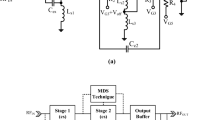Abstract
A low noise figure (NF) and high power gain (S21) 3–10 GHz ultra-wideband (UWB) low noise amplifier (LNA) in 65 nm CMOS technology is proposed for UWB system which has a high figure of merit. A shunt–shunt resistive feedback technique is used to achieve wideband input impedance matching. A differential current-reused structure is used to achieve high common noise suppression and low power consumption. The implemented LNA achieves a high and flat aS21 of 15.6 ± 1.07 dB with an input return loss (S11) which is better than − 8.7 dB and a low NF of 2.99 ± 0.18 dB at frequencies of 3–10 GHz. The measured input third-order intermodulation point (IIP3) is − 5.7 dBm at 6 GHz.











Similar content being viewed by others
References
Lin, Y. S., Chen, C. Z., Yang, H. Y., et al. (2010). Analysis and design of a CMOS UWB LNA with dual-RLC-branch wideband input matching network. IEEE Transactions on Microwave Theory and Techniques,58(2), 287–296.
Galal, A. I. A., Pokharel, R. K., Kanay, H., et al. (2010). Ultra-wideband low noise amplifier with shunt resistive feedback in 0.18 µm CMOS process. In Silicon monolithic integrated circuits in RF systems, IEEE, pp. 33–36.
Arshad, S., Zafar, F., Ramzan, R., et al. (2013). Wideband and multiband CMOS LNAs. Microelectronics Journal,44(9), 774–786.
Hsu, M. T., Hsieh, Y. C., & Ou, A. C. (2012). Design of low power UWB CMOS LNA using RC feedback and body-bias technology. In International conference on Asic, IEEE, pp. 1–4.
Chen, K. H., & Liu, S. I. (2012). Inductorless wideband CMOS low-noise amplifiers using noise-canceling technique. IEEE Transactions on Circuits and Systems I: Regular Papers,59(2), 305–314.
Pandey, S., Gawande, T., & Kondekar, P. N. (2017). A 0.9 V, 4.57 mW UWB LNA with improved gain and low power consumption for 3.1–10.6 GHz ultra-wide band applications. Wireless Personal Communications,96(1), 583–597.
Nigam, S., & Sau, P. C. (2016). Design of UWB LNA using active resistors in 0.18 µm CMOS technology. In Communication, control and intelligent systems, IEEE, pp. 393–397.
Najari, O. E., Arnborg, T., & Alvandpour, A. (2010). Wideband inductorless LNA employing simultaneous 2nd and 3rd order distortion cancellation. In Norchip, IEEE, pp. 1–4.
Pan, Z., Qin, C., Ye, Z., et al. (2017). Wideband inductorless low-power LNAs with Gm enhancement and noise-cancellation. IEEE Transactions on Circuits and Systems I: Regular Papers,PP(99), 1.
Dai, R., Zheng, Y., He, J., et al. (2014). A 2.5-GHz 8.9-dBm IIP3 current-reused LNA in 0.18-μm CMOS technology. In IEEE international symposium on radio-frequency integration technology, IEEE, pp. 1–3.
Erfani, R., Marefat, F., & Ehsanian, M. (2014). Self-biased resistive-feedback current-reused CMOS UWB LNA with 1.7 dB nf for IR-UWB applications. In International conference on microelectronics, IEEE, pp. 132–135.
Guo, J. C., Lin, C. S., & Liang, Y. T. (2017). Low voltage and low power UWB CMOS LNA using current-reused and forward body biasing techniques. In Microwave symposium, IEEE, pp. 764–767.
Yang, H. Y., Lin, Y. S., & Chen, C. C. (2008). 2.5 dB NF 3.1–10.6 GHz CMOS UWB LNA with small group-delay variation. Electronics Letters,44(8), 528–529.
Wu, L., Leung, H. F., & Luong, H. C. (2017). Design and analysis of CMOS LNAs with transformer feedback for wideband input matching and noise cancellation. IEEE Transactions on Circuits and Systems I: Regular Papers,PP(99), 1–10.
Wu, C., Lin, Y., & Wang, C. (2013). A 3.1–10.6-GHz current-reused CMOS ultra-wideband low-noise amplifier using self-forward body bias and forward combining techniques. Microwave and Optical Technology Letters,55(10), 2296–2302.
Li, N., Feng, W., & Li, X. (2017). A CMOS 3–12-GHz ultrawideband low noise amplifier by dual-resonance network. IEEE Microwave and Wireless Components Letters,27(4), 383–385.
Hsu, M. T., Chang, Y. C., & Huang, Y. Z. (2013). Design of low power UWB LNA based on common source topology with current-reused technique. Microelectronics Journal,44(12), 1223–1230.
Funding
The funding was provided by National Natural Science Foundation of China (Grand No. 61874082).
Author information
Authors and Affiliations
Corresponding author
Additional information
Publisher's Note
Springer Nature remains neutral with regard to jurisdictional claims in published maps and institutional affiliations.
Rights and permissions
About this article
Cite this article
Luo, P., Liu, M., Chen, L. et al. A 2.99 dB NF 15.6 dB Gain 3-10GHz Ultra-wideband low-noise amplifier for UWB systems in 65 nm CMOS. Analog Integr Circ Sig Process 101, 651–657 (2019). https://doi.org/10.1007/s10470-019-01547-2
Received:
Revised:
Accepted:
Published:
Issue Date:
DOI: https://doi.org/10.1007/s10470-019-01547-2




